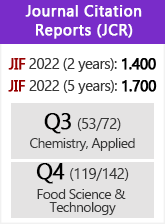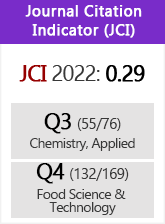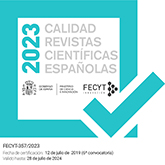Oleogels of virgin olive oil with carnauba wax and monoglyceride as spreadable products
DOI:
https://doi.org/10.3989/gya.0349141Keywords:
Carnauba wax, Monoglyceride, Oleogel, Storage, Virgin olive oil, X-ray diffractionAbstract
The oleogels of virgin olive oil with carnauba wax and monoglyceride were prepared to determine the most suitable spreadable product. The oil binding capacities of monoglyceride oleogels were higher than those of the carnauba wax oleogels. There was no true crystalline structure with carnauba wax at 3%. Although the highest solid fat content was in the 10% monoglyceride oleogel (9.38%), it was 12.15% in the commercial breakfast margarine at 20 °C. The peak melting temperature of the margarine was 47.11 °C, and among all oleogels, monoglyceride oleogel at 7% addition had the closest value (48.70 °C). The melting enthalpies of the oleogels ranged from 1.25 to 103.97 J·g−1, while it was 94.19 J·g−1 for the margarine sample. The firmness and stickiness values were usually lower in the oleogel samples than those of the margarine sample. There was no significant change in the texture parameters during storage, indicating good structural stability. The polarized light microscopy pictures revealed rod-like crystals for carnauba wax and rosette-like aggregates for monoglyceride oleogels. X-ray diffraction patterns of the samples have revealed a β´-type polymorphic structure for the oleogels. These oleogels can be used in a spreadable, breakfast margarin-like product to promote new consumption habits for this healthy oil.
Downloads
References
AOCS. 1987. Peroxide value acetic acid – chloroform method (Cd 8-53). American Oil Chemists' Society. AOCS Press, Champaign, US.
Batte HD, Wright AJ, Rush JW, Idziak SHJ, Marangoni AG. 2007. Effect of processing conditions on the structure of monostearin–oil–water gels. Food Res. Int. 40, 982–988. http://dx.doi.org/10.1016/j.foodres.2007.05.001
Boskou D. 1996. Olive Oil: Chemistry and Technology. AOCS Press, Champaign, US.
Bot A, Veldhuizen YSJ, den Adel R, Roijers EC. 2009. Non-TAG structuring of edible oils and emulsions. Food Hydrocoloid. 23, 1184–1189. http://dx.doi.org/10.1016/j.foodhyd.2008.06.009
Chrysam MM. 1996. Margarines and Spreads. In Y.H. Hui (Ed.). Bailey's Industrial Oil & Fat Products. Wiley-Intersience Pub, New York, 65–114.
Co ED, Marangoni AG. 2012. Organogels: An alternative edible oil-structuring method. J. Am. Oil Chem. Soc. 89, 749–780. http://dx.doi.org/10.1007/s11746-012-2049-3
Da Pieve S, Calligaris S, Co E, Nicoli MC, Marangoni AG. 2010. Shear nanostructuring of monoglyceride organogels. Food Biophys. 5, 211–217. http://dx.doi.org/10.1007/s11483-010-9162-3
Da Pieve S, Calligaris S, Panozzo A, Arrighetti G, Nicoli MC. 2011. Effect of monoglyceride organogel structure on cod liver oil stability. Food Res. Int. 44, 2978–2984. http://dx.doi.org/10.1016/j.foodres.2011.07.011
Dassanayake LSK, Kodali DR, Ueno S. 2011. Formation of oleogels based on edible lipid materials. Current Opinion in Colloid Interface Sci. 16, 432–439. http://dx.doi.org/10.1016/j.cocis.2011.05.005
Dassanayake LSK, Kodali DR, Ueno S, Sato K. 2009. Physical properties of rice bran wax in bulk and organogels. J. Am. Oil Chem. Soc. 86, 1163–1173. http://dx.doi.org/10.1007/s11746-009-1464-6
Glibowski P, Zarzycki P, Krzepkowska M. 2008. The rheological and instrumental textural properties of selected table fats. Int. J. Food Properties 11, 678–686. http://dx.doi.org/10.1080/10942910701622599
den Adel R, Heussen PCM, Bot A. 2010. Effect of water on self-assembled tubules in α-sitosterol +β-oryzanol-based organogels. J. Physics: Conference Series 247, 012025. http://dx.doi.org/10.1088/1742-6596/247/1/012025
Hwang HS, Kim S, Singh M, Winkler-Moser JK, Liu SX. 2012. Organogel formation of soybean oil with waxes. J. Am. Oil Chem. Soc. 89, 639–647. http://dx.doi.org/10.1007/s11746-011-1953-2
Kesselman E, Shimoni E. 2007. Imaging of oil/monoglyceride networks by polarizing near-field scanning optical microscopy. Food Biophys. 2, 117–123. http://dx.doi.org/10.1007/s11483-007-9038-3
Lupi FR, Gabriele D, de Cindio B, Sanchez MC, Gallegos C. 2011. A rheological analysis of structured water-in-olive oil emulsions. J. Food Eng. 107, 296–303. http://dx.doi.org/10.1016/j.jfoodeng.2011.07.013
Lupi FR, Gabriele D, Facciolo D, Baldino N, Seta L, de Cindio B. 2012. Effect of organogelator and fat source on rheological properties of olive oil-based organogels. Food Res. Int. 46, 177–184. http://dx.doi.org/10.1016/j.foodres.2011.11.029
Lupi FR, Gabriele D, Greco V, Baldino N, Seta L, de Cindio B. 2013a. A rheological characterisation of an olive oil/fatty alcohols organogel. Food Res. Int. 51, 510–517. http://dx.doi.org/10.1016/j.foodres.2013.01.013
Lupi FR, Gabriele D, Greco V, Baldino N, Mijovic P, Parisi OI, and Puoci F. 2013b. Olive oil/policosanol organogels for nutraceutical and drug delivery purposes. Food Funct. 4, 1512–1520. http://dx.doi.org/10.1039/c3fo60259a PMid:24056806
Mezzenga R. 2011. Protein-templated oil gels and powders. In Marangoni AG, Garti N (eds). Edible oleogels: Structure and Health Implications. AOCS Press, Urbana, US, 271–293.
Moskowitz HR. 1987. Food Texture- Instrumental and Sensory Measurements. Marcel Dekker, New York, US.
Ojijo NKO, Kesselman E, Shuster V, Eichler S, Eger S, Neeman I, Shimoni E. 2004. Changes in microstructural, thermal, and rheological properties of olive oil/monoglyceride networks during storage. Food Res. Int. 37, 385–393. http://dx.doi.org/10.1016/j.foodres.2004.02.003
Ögutcu. M, Yılmaz E. 2014. Properties and stability of hazelnut oil organogels with beeswax and monoglyceride. J. Am. Oil Chem. Soc. DOI: 10.1007/s11746-014-2434-1. http://dx.doi.org/10.1007/s11746-014-2434-1
Patel AR, Schatteman D, De Vos WH, Dewettinck K. 2013. Shellac as a natural material to structure a liquid oil-based reversible soft matter system. RSC Advances 3, 5324–5327. http://dx.doi.org/10.1039/c3ra40934a
Patel AR, Rajarethinem PS, Gredowska A, Turhan O, Lesaffer A, De Vos WH, de Walle DV, Dewettinck K. 2014. Edible applications of shellac oleogels: spreads, chocolate paste and cakes. Food Funct. 5, 645–652. http://dx.doi.org/10.1039/c4fo00034j PMid:24647527
Rogers MA. 2009. Novel structuring strategies for unsaturated fats – Meeting the zero-trans, zero-saturated fat challenge: A review. Food Res. Int. 42, 747–753. http://dx.doi.org/10.1016/j.foodres.2009.02.024
Rush JWE, Jantzi PS, Dupak K, Idziak SHJ, Marangoni AG. 2008. Effect of food preparation on the structure and metabolic responses to a monostearin–oil–water gel based spread. Food Res. Int. 41, 1065–1071. http://dx.doi.org/10.1016/j.foodres.2008.07.017
Stortz TA, Zetzl AK, Barbut S, Cattaruzza A, Marangoni AG. 2012. Edible oleogels in food products to help maximize health benefits and improve nutritional profiles. Lipid Technol. 24, 151–154. http://dx.doi.org/10.1002/lite.201200205
Toro-Vazquez JF, Morales-Rueda JA, Dibildox-Alvarado E, Charo-Alonso M, Alonzo-Macias M, Gonzales-Chavez MM. 2007. Thermal and textural properties of organogels developed by candelilla wax in safflower oil. J. Am. Oil Chem. Soc. 84, 989–1000. http://dx.doi.org/10.1007/s11746-007-1139-0
Toro-Vasquez JF, Mauricio-Perez R, Gonzales-Chavez MM, Sanchez-Becerril M, Ornelas-Paz JJ, Perez-Martinez JD. 2013. Physical properties of organogels and water in oil emulsions structured by mixtures of candelilla wax and monoglycerides. Food Res. Int. 54, 1360–1368. http://dx.doi.org/10.1016/j.foodres.2013.09.046
Published
How to Cite
Issue
Section
License
Copyright (c) 2014 Consejo Superior de Investigaciones Científicas (CSIC)

This work is licensed under a Creative Commons Attribution 4.0 International License.
© CSIC. Manuscripts published in both the printed and online versions of this Journal are the property of Consejo Superior de Investigaciones Científicas, and quoting this source is a requirement for any partial or full reproduction.All contents of this electronic edition, except where otherwise noted, are distributed under a “Creative Commons Attribution 4.0 International” (CC BY 4.0) License. You may read here the basic information and the legal text of the license. The indication of the CC BY 4.0 License must be expressly stated in this way when necessary.
Self-archiving in repositories, personal webpages or similar, of any version other than the published by the Editor, is not allowed.
















